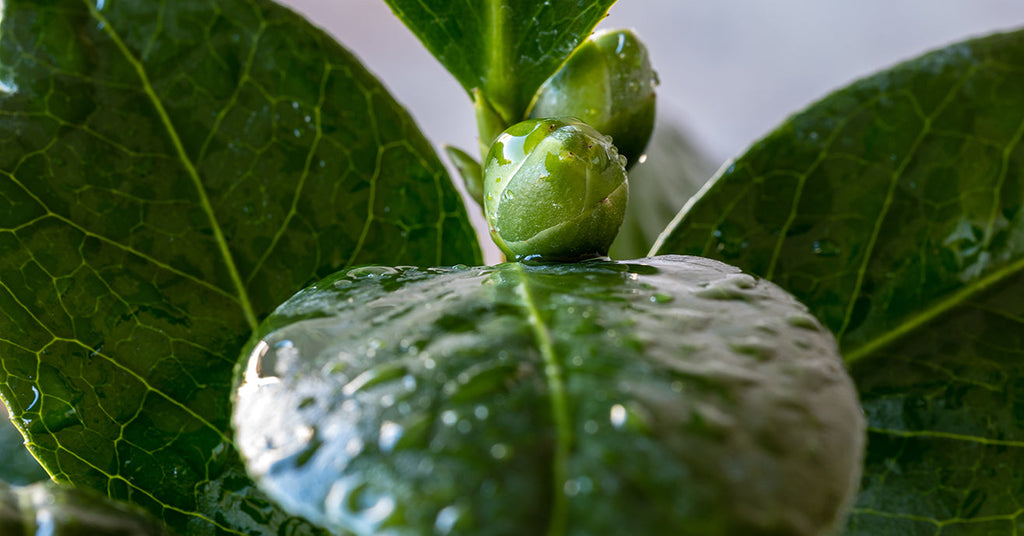Grow Your Own Tea Plant

Do you enjoy getting your hands in the soil, feeling the earth between your fingers? Do you often have a cup (or tumbler) of tea nearby as you do? There’s a wonderful way to combine your love of tea with your passion for gardening—that’s by growing your own tea bush at home!
With the below tips from our friends at Minto Island Tea Company, pioneers of growing and crafting tea here in the US, as well as Alicia Gentili, who has grown tea around the world, you’ll have your very own Camellia sinensis sprouting in no time.
Can You Grow Tea Plants At Home?
The answer is a resounding “yes!” The plant from which all true tea is made, Camellia sinensis, grows to be a large shrub or small tree. Typically, it grows to be a beautiful three-to-five-foot-tall cultivated hedge. You can grow the tea plant indoors, or, provided you have a favorable climate, outdoors as well (more on favorable conditions below.)

How Do You Plant A Tea Bush?
For those who live in our backyard (the Pacific Northwest), the ideal planting time is between April and late-August. If planted too soon (or too late), the plant may be susceptible to frostbite. If you hail from another part of the country, research your best growing times and conditions by contacting the US League of Tea Growers.
If you want to move the tea bush from a pot into the ground, wait until your plant start is about 1-2 years old. It should also go through a small period of hardening off (placing the plant outdoors to acclimate).
If you've ever planted a shrub, you'll be familiar with the process. Dig a hole that's as deep as the root ball but twice as wide. Make sure the top of the root is level with the soil height. Backfill with mostly native soil that's amended with well-aged compost. While the tea plant is establishing, mulch the area with sawdust, leaves, or compost, especially in early fall before temperatures drop. Easy peasy.
What Type Of Soil Works Best For Planting Tea?
Camellia sinensis grows in acidic soils, ideally with a pH of 4.5-6. This is similar to the kind of soil where blueberries thrive, so if those are growing well on your garden plot, you can probably grow tea too. To prevent the roots from rotting, you'll need adequate drainage. In wetter sites, consider using a raised bed with extra compost amendments.
How Far Apart Should Plants Be Spaced?
For hedge plantings in a production setting, individual saplings can be spaced between 1.5 feet to 3 feet apart. But for regular, at-home gardens with just a few plants, allow for at least five feet in between each plant. We suggest pruning frequently to encourage branching and numerous growing tips—optimal tea plucking conditions!
How Much Light Does A Tea Plant Need?
Tea plants grow best in the mountains, which offer cycles of strong sunlight and heavy rains. Here in the Pacific Northwest, try for sites with full sun. Try to avoid garden plots that are fully shaded, as they need at least some sunlight to become hardy, vigorous plants.
How Long Does A Tea Plant Take to Grow?
You shouldn’t harvest leaves from your plant until it is at least three years old. After that, if well cared, your tea bush should last at least 50 years, if not hundreds!
How Much Water Does A Tea Plant Need?
Tea plants need at least 60 inches of water per year. They love water, but hate sitting in it so making sure they are in a well drained environment (with sandy/rocky soil or planted on a slope) is essential.
For the first two years, before the plant is well-established, water two or three times each week throughout the summer. When young saplings, they need a significant amount of water, so ensure the entire root ball is soaked through before turning off the spigot. Once the plant is more established, watering regularly during dry summers will encourage more growth of new shoots, but take care not to overwater.

What Are Tea Flowers Used For?
Typically, The flowers are typically white andlook similar to (only smaller than) the ornamental camellia. If you want to have the tea plants around for their ornamental charm, then leaving the flowers be and allowing them to bloom will make for an even more attractive plant.
Commercial tea growers discourage flowers from blooming because the blossoms redirect nutrients away from the leaf, which is what makes tea. If you don't plan on processing your harvest into tea, it’s okay to leave the showy flowers on your tea bush.In fact, the blooms can be made into their own delicious, relaxing brew that is smooth and sweet.
If you do want to grow your tea plant mostly for the purposes of tea making, then the shrub should be harvested just as the bud first appears. This ensures the plant's energy is going into its leaves, leading to a more complex finished cup. Learn more about why only harvesting the top two leaves and a bud make its finished flavors pop.
Where Can I buy A Tea Plant?
Minto Island sometimes sells tea saplings for those who can visit their farm stand near Portland, Oregon. Some other resources for purchasing saplings and seeds:
- Camellia Forest Nursery
- Fast Growing Trees
- Angela, founder of Oregon Tea Traders, often sells plants in our hometown of Eugene, Oregon
How Can I Process My Tea Leaves Into Tea I Can Drink?
While it has taken centuries for many cultures across the world to develop the precise art of processing tea, there are definitely simple and less intimidating methods that you can apply to process tea at home, and with minimal equipment. Here are a few good resources we found to shed more light on at-home tea processing:
-
Camellia Forest Tea Garden's tips for processing your tea leaves into tea you can drink (Located in Chapel Hill, NC)
- Renegade Tea Estate's tips for processing your tea leaves into tea you can drink (Located in the country of Georgia)
Too busy to grow your own?
SHOP OUR COLLECTION OF SPECIALTY TEAS
You might also be interested in:
Blog Author:

Raj Vable, Founder
He has been confounded by the leaf since his first transcendental encounter with white tea in 2010. Three years later, he started Young Mountain Tea to bridge his budding tea obsession with his interest in traveling in the mountains and previous experience creating job opportunities in rural India. He revels in working across cultures and can be regularly found trying to get the rest of the team on board with another outlandish tea project. His favorite teas remain white, and he’s always searching for the next cup of magic.




Comments on this post (10)
Where can I source tea plants in Oregon? I live very close to Minto Island, Salem, Oregon. Thanks!
— Rob
Hi Robin, that’s a great question! Unfortunately we don’t know the answer, but since tea is a relative of ornamental Camellias, I recommend chatting with your local nursery, they should be able to guide you regarding the best moving/replanting windows.
— Raj
When can I move my Korean tea. It has been in my garden for 2 years. Growing beautifuly but I need to move it due to a project that need that space
— Robin
Hi Gretchen,
Great question! The answer depends on how productive your tea bushes are. A standard cup of tea is 2.5 grams, so 2 cups/day = 5 grams/day. If you drink that every single day, 5 × 365 = 1.83 kg of finished tea per year, which is what’d you need. Usually, it’s a 5:1 ratio for harvested leaf to finished tea, so that makes it about 9 kg/year of harvested leaf. That’s your target, good luck!
— Raj Vable
We would love to grow enough for our tea-drinking needs. How many plants would we need to produce 2 cups of green tea per day?
We live in the PNW, in the foothills of Mt Rainier. We are mountainous with heavy rains, and good sun when it is out — so maybe ideal conditions??? Also a few feet of snow in the winter and freezing weather, though our soil does not freeze.
— Gretchen Jones
Hi Kristin! It’s worth trying! The hardest requirement is acidic soil (a pH of 4.5-6), so if blueberries grow, it should be possible. Tea doesn’t handle frost well, but if the snow falls and blankets it completely, it should be alright. Disclaimer: we aren’t tea farmers. :)
— Raj Vable
I would love to grow some tea plants in Cushing, Maine. Is that possible? It would be south side, some birch tree shade but cold winters.
Thanks
— Kristin Cooper
Hi Patricia! Tea plants are definitely happiest in the ground, not in a pot. That said, we know of folks locally who have thriving potted trees, so it is possible. Whether in a pot or in the ground, the hardest requirement is acidic soil (pH of 4.5-6), so we’d suggest starting there to see if that’s part of it. If you’re considering moving the plants outdoors, generally, if you can grow blueberries, you can grow tea in the same soil. They also like well-drained soil because they’re susceptible to root rot if there’s any standing water. We know of many friends here in Oregon who grow tea outdoors, including one of the country’s only domestic commercial growers, Minto Island outside of Salem. If you’re interested in learning more, the US League of Tea Growers has some great resources, and has a PNW regional hub. Here’s where you can learn more: https://usteagrowers.com/
Good luck! We’re excited to hear how it goes!
— Young Mountain Tea
My two tea plants are in pots in an unheated greenhouse. They have lost all their leaves. Did they get damaged by cold weather? What should I do to revive them? Would they be better off outside? I live in Oregon, Willamette Valley Zone 8. Thanks for any advice!
— Patricia Farrell
Amazing write-up!
We’re glad to hear that you’re enjoying your tea plant and tea leaves, As for light, we have found that tea plants like medium light so a sunny windowsill would be perfect for your plant! You can also use a grow light if you don’t have a sunny window.
— Tea Chai Te